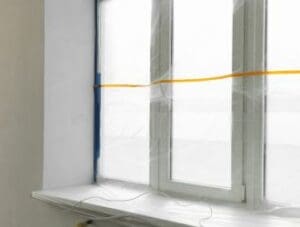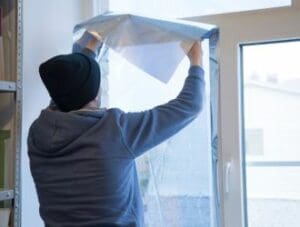Insulating Window Film Guide

Does window insulating film actually conserve energy and maintain comfortable home temperatures?
Absolutely.

Build your window today!
Get a Quote
In this guide, we unpack the effectiveness of insulating film for windows, its installation process, and the options available for various window types.
Discover the straightforward steps to potentially lower energy bills and boost indoor comfort.
Thermal Window Film - In Summary
- Window insulating film provides an economical way to enhance the thermal insulation of glass windows. This leads to consistent indoor temperatures, reduced energy bills, and diminished greenhouse gas emissions.
- There are specialised types of insulating film for single, double, and triple-pane windows, each optimised for different insulation levels and benefits such as UV protection, heat retention, and noise reduction.
- Proper installation and maintenance of window insulating film is important for maximising energy efficiency and preventing issues such as mould growth; commercial buildings especially can achieve significant long-term energy savings and quick cost recovery with film insulation.
Understanding Window Insulating Film
Before we discuss different types of insulation or how to install them, we will explain what insulation is actually like so that you can better determine whether you need it.
Insulating window film is a smart and cost-effective solution that can revolutionise indoor temperature management.
When applied to glass windows, this film offers an additional layer of thermal insulation, reducing heat gain during summer and heat loss in winter.
Using window films ensures a consistent indoor environment throughout the year, significantly reducing energy bills.
The film is transparent and virtually unnoticeable once applied, allowing you to continue using your windows without any obstruction.
A broad range of window insulating films is available in the market, each designed to meet specific needs.
For instance, secondary glazing films, such as Low-E and 3M Thinsulate films, provide improved insulation performance, blocking up to 70% of solar heat gain and enhancing energy efficiency.
Window insulating film is a versatile solution that improves the comfort of your home or office and contributes positively to the environment by reducing energy consumption and greenhouse gas emissions.
Different types of window films are designed for specific purposes.
For example, privacy window film will also help improve energy efficiency, but it is mainly manufactured to block the view through the window inside, giving you more privacy and peace.
Types of Window Insulating Films
Now, I'm sure you're thinking, "That sounds great!" But there are a few more things you should know before rushing to make the purchase, such as the types of insulating window film.
A variety of window insulating films cater to different needs.
They range from films for single-pane windows to those designed for double and triple-glazing units. Each type is engineered to improve insulation and energy efficiency uniquely.
We will examine each type in detail below.
Single Pane Window Insulating Film
Single-pane windows are commonly found in older buildings. While they may add a vintage charm, they, unfortunately, lack insulation. That’s where single-pane window insulating film comes in.
It significantly increases heat retention by up to 40% and retains up to 55% more heat during winter, reducing energy usage and improving insulation for your home.
One remarkable feature of the single pane window insulating film, specifically designed for single pane glass window frames, is its ability to:
- Block nearly all UV rays
- Serve as a protective barrier, safeguarding your interior from the detrimental impact of UV radiation
- Prolong the life of your furnishings and furniture
Type 1 (EC100) thermal window film is recommended for single glazing. You can easily install it using double-sided tape, scissors, and a hairdryer to ensure a better seal.
Double-Glazing Window Insulation Film
Double-glazed windows, also known as double-glazing windows, are increasingly becoming popular due to their enhanced insulation properties.
However, applying window insulation film can further enhance these properties by creating a thermal barrier that reflects heat back into the room, thereby preventing heat loss and improving insulation.
This can also be applied to doors if you are insulating a front door in your home.
Certain measures must be taken before applying heat-reducing film to double-glazed windows. Ensure that the internal pane of the double-glazed unit is made of toughened glass by checking the kite mark.
Also, select film designed for external use as double-glazed units can retain heat within the panes, functioning like large radiators.
To apply the heat-reducing film, spray the glass and the adhesive side with a mild soapy water solution.
Adhere the film to the glass with a squeegee, smoothing it out to eliminate residual water and ensure a proper seal.
Triple Glazing Insulation Film
For the highest level of insulation and energy efficiency, a triple-glazing insulation film is the way to go.
Designed to enhance the thermal and sound insulation of triple-glazed windows, it is an ideal solution for colder climates and high-performance buildings.

Triple-glazing insulation film offers superior insulation compared to single- and double-glazing.
This is due to the inclusion of a gas layer and iron oxide film between the glass panes, which contribute to its enhanced efficiency.
In addition, triple-glazed insulation film will be stronger and more durable than double-glazed film.
Although window security film might be the best option if you are looking for protection.
In colder climates, it offers benefits such as reduced energy consumption, lower carbon footprint, improved interior comfort and warmth, and decreased noise transmission.
Beyond residential buildings, triple glazing insulation film also finds application in:
- High-performance commercial buildings
- Buildings that need to surpass Building Regulations standards for energy efficiency
- Buildings that require superior sound insulation compared to double glazing, with up to 30% more effectiveness
- Buildings that need UV protection to prevent interior fading and damage.
To learn more about the triple-glazing cost for your home in the UK, please check out our guide.
Insulating Film Installation and Maintenance
Like most things in your home, you will get this insulation fitted and maintain it to get the best out of it, which is what we all want.
The installation of insulating film is quite straightforward. Here are the steps to follow:
- Start by cleaning the window surface with isopropyl alcohol or another cleaning solution.
- Unroll the adhesive window film with the adhesive side facing up.
- Apply the film to the window, ensuring it’s properly adhered to the window frame without gaps where air could escape.
It is also important to maintain the film after installation. This involves cleaning with a mild solution, such as a mix of baby shampoo and cold water.
Harsh chemicals or abrasive materials should be avoided, as they could damage the film.
However, remember that trapped moisture may cause condensation between the window and the film, which could lead to mould growth and damage to window seals.
Using correct installation methods is key to stopping condensation on windows.
Impact of Insulating Film on Energy Efficiency
Efficiency is one of the most common things mentioned when discussing household installations and furniture, and there's a reason why!
Energy efficiency means that you won't be using as much energy throughout the day or won't lose as much heating, which can save you money.
Insulating film significantly influences energy efficiency. Minimising heat loss through windows and enhancing insulation substantially lowers energy consumption, leading to substantial energy savings.
Often, the film can recoup its investment within a short timeframe.
The insulation performance of window film is sustained by its ability to keep heat out in the summer and lock the heat in during the winter. Solar control films offer an added layer of insulation in colder months, reducing energy waste and decreasing heating expenses.
In the UK, government window grants are available for those looking to insulate and improve the energy efficiency of their windows. However, this included double-glazed windows rather than insulation film.
Still, window insulation film is a great addition to your home and will further enhance the energy-saving ability of any property.
Commercial buildings particularly benefit from window film insulation because:
- It is durable, lasting up to 12 years
- It provides significant long-term benefits
- It has a quick cost recovery, especially given high energy costs and variable revenue
This makes window film insulation a sound investment for commercial buildings.
UV Protection and Glare Reduction for Insulation Film
Insulation film offers several benefits, including:
- Temperature control
- UV protection
- Glare reduction
- Blocking 99% of ultraviolet radiation protects the interior against harmful UV rays and prolongs the life of furnishings.

Tinted or heat-reflective window film can effectively reduce glare from sunlight, allowing a pleasant amount of natural light indoors while minimising radiant heat.
Insulation film regulates sunlight entering through windows, controls indoor temperatures, and reduces the workload of heating, ventilation, and air conditioning (HVAC) systems, such as trickle vent windows.
Customising Insulating Film Solution
We all love freedom of choice, don't we? There are various insulating window film solutions for your home.
When considering insulating film solutions, you can choose a cut-to-size film or standard sizes. Choosing cut-to-size window insulation films has its advantages:
- Perfect fit
- Better insulation
- Energy cost savings
- Durability
- Moisture resistance
- Protection from damaging UV rays
Various factors need to be considered when selecting the thickness of insulating film. These include insulation costs, materials and installation costs, and the desired R-value to attain the necessary insulation efficiency.
Thus, customising insulating film solutions allows for a more tailored approach to insulation and energy efficiency improvements, ensuring your needs are met.
You can even add more aesthetic additions to your windows, such as Georgian bars and astragal bars, which can be installed in or with your windows without compromising the insulation.
Window Insulation Film - Our Verdict
As our guide concludes, you should feel more informed about insulation film.
Window insulating film offers a simple yet effective solution that can significantly enhance your home or office's comfort and energy efficiency.
It offers an additional layer of thermal insulation, reducing heat gain during summer and heat loss in winter and providing UV protection.
Various types are available, so you can choose the one that best suits your specific needs and preferences.
Insulating film helps maintain a comfortable indoor temperature year-round and contributes to environmental sustainability by reducing energy consumption.
So, consider investing in window-insulating films – a wise move offering immediate and long-term benefits.
Frequently Asked Questions
Does window insulation film actually work?
Yes, window insulation film does work by helping with heat retention, but it's not a solution for air leak problems or inadequate house insulation.
Can window film help insulate?
Window film can help insulate your home by increasing insulation and heat retention. It is a cost-effective and easy-to-install option.

What is the purpose of window insulating film?
Window insulating film aims to offer an additional layer of thermal insulation.
It helps regulate indoor temperature by minimising heat gain in summer and heat loss in winter.
This ensures a consistent and comfortable environment year-round.
What are the benefits of single-pane window insulating film?
Using single-pane window insulating film can increase heat retention by up to 40% and save up to 55% more heat during winter, reducing energy usage and improving insulation.
What advantages does triple-glazing insulation film provide for regions with colder climates?
Triple-glazing insulation film provides advantages in colder climates, including reduced energy consumption, a lower carbon footprint, improved interior comfort and warmth, and decreased noise transmission.
It is a beneficial choice for these regions.









